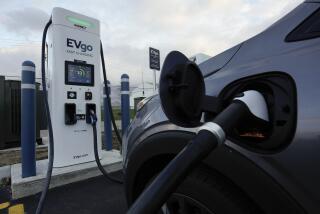U.S. auto sales zoom up 22% in June
If consumer confidence is lagging, it’s not hurting enough to stop people from buying cars.
Despite the economic pall hanging over the U.S. economy, consumers are buying cars in greater numbers than they have in years, purchases that could help insulate America from another recession.
Automakers sold almost 1.3 million vehicles in June, a 22% gain from a year earlier, exceeding the expectations of many analysts who had projected a slower month amid dimming economic measures.
Although consumer sentiment and spending have slid in recent months, auto buyers have trekked to dealerships, enticed by lower interest rates, easier-to-get loans and the need to replace aging vehicles.
“The combination of new products, available credit, lower fuel prices and modest economic growth was a stronger influence on consumer behavior than economic and political uncertainty,” said Kurt McNeil, vice president of U.S. sales operations at General Motors Co.
Most of the major automakers posted double-digit gains compared with June 2011. Japanese brands had among the biggest increases as they rebounded from production and supply issues caused by last year’s earthquake and tsunami.
Overall, the annual pace of sales in June and for the first half of the year was well above 14 million vehicles, the best rate in years. Through the first half of this year, the industry has sold 15% more vehicles than in the same period last year.
The gain has come despite tepid consumer enthusiasm for spending in recent months. An index of sentiment compiled by the Conference Board slid to 62 in June from 64.4 in May, the fourth consecutive monthly decline. Consumer spending slipped slightly in May, posting its weakest showing since November, according to the Commerce Department.
Economists said consumers are spooked by a lack of job growth in the U.S. and uncertainty about the federal budget, potential tax increases and the presidential election as well as economic turmoil in Europe.
Nonetheless, automakers are upbeat about the second half of the year.
That confidence is reflected in the industry by a series of big factory investment and expansion plans by domestic manufacturers and foreign brands.
GM said last week that it would add a third shift and 800 jobs at its factory in Arlington, Texas, where it makes large sport utility vehicles including the Chevrolet Suburban and Cadillac Escalade. Hiring will begin in the fourth quarter and production will start early next year.
Nissan North America said last week that it would build a redesigned version of the Sentra compact car at its Canton, Miss., factory beginning in the fourth quarter. The Sentra production, along with a November shift in pickup truck and SUV assembly to the factory, will create 1,000 jobs, the automaker said.
Those types of expansions and a nascent recovery in the housing market reassure Beth Ann Bovino, senior economist at Standard & Poor’s.
“I am concerned, but not as gloomy as I was last September,” Bovino said. “We are still seeing people spend on cars. People are starting to buy new homes. That means they will have to fill them with stuff and retail will pick up as well.”
A rebound in housing — especially new homes — should be particularly good for the pickup truck market.
“They are joined at the hip,” said Ellen Hughes-Cromwick, Ford Motor Co.’s chief economist.
Despite the economic jitters, the people buying new cars “are doing OK,” Hughes-Cromwick said. “They’ve got a good income profile. They have lower than average unemployment rates.”
Low interest rates and ubiquitous financing options of zero to 1.9% also are a big pull, she said.
Many consumers have delayed purchasing a new vehicle throughout the recession and the sluggish recovery and now drive cars approaching 10 years or older, analysts said. They can’t delay much longer.
“If a family in Iowa’s only mode of transportation is on the fritz, they are going to buy a replacement vehicle, even if Spain’s economy is on the brink of collapse,” said Alec Gutierrez, senior market analyst of automotive insights at auto information company Kelley Blue Book.
One sign of the health of the industry is that the transaction price for vehicles continues to rise with consumer demand.
The average transaction price for light vehicles in the United States was $30,508 in June, up $849, or 2.9%, from a year earlier and up $148, or 0.5%, from May, according to auto price information company TrueCar.com.
GM, the nation’s largest automaker, sold 248,750 vehicles in June, a 15.5% rise over the same period a year earlier, according to Autodata Corp. GM said it was the company’s highest monthly sales figure since September 2008. The Chevrolet, Buick, GMC and Cadillac brands all logged double-digit increases.
Chrysler Group posted sales of 144,811 vehicles in June, a 20.3% increase from the same month a year earlier and the company’s best June since 2007.
Ford’s June sales rose 7.1% to 207,204 vehicles.
Toyota Motor Corp. said its sales rose 60.3% to 177,795 units in June. The big increase was largely attributed to multiple new models and a recovery from an inventory and production crunch created by the 2011 Japanese earthquake and tsunami.
Encouraged by the results, Toyota increased its estimate of total industry light vehicle sales to 14.3 million this year from its previous forecast of 13.5 million. The automaker also said its U.S. sales were on pace to cross the 2 million mark this year.
Honda Motor Co., also recovering from the earthquake, saw June sales rise 48.8% to 124,808 vehicles. Nissan North America sales rose 28.2% to 92,237 vehicles.
Volkswagen of America said it sold 38,170 vehicles in June, a 34.2% increase over the same month a year earlier. It was the best June and the best first six months of the year for the VW brand since 1973.







